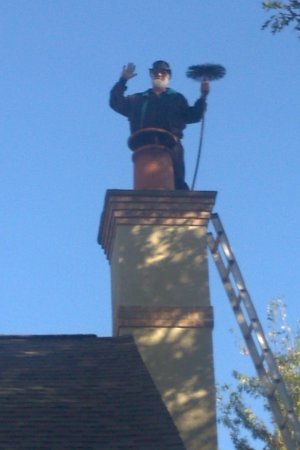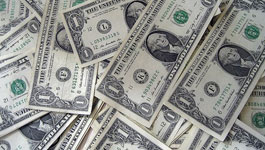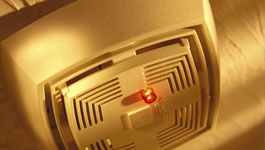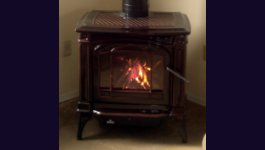Choosing the Right Firewood

Choosing the Right Firewood
The Simple Answer
Always burn well seasoned wood. The species makes a difference, but it is not as important as properly seasoned wood. Hardwood is preferable, but softwood is OK to burn also. Burning your appliance correctly is the first line of defense against chimney fire and the best way to enjoy the ambiance and heat from it.
A More Complete Answer
When selecting firewood most folks are concerned with two things, how much heat they will get and how much creosote will result from burning that wood. Let’s focus on the creosote first.
When burning wood it is undergoing a chemical reaction called pyrolysis. During this process some of the wood is being converted to gasses. In fact, the flames we see are nothing more than those gasses in a superheated state. The problem is that not all of those gasses are consumed during primary combustion. The unburnt gasses rise into the chimney where they cool and condense. Just like water droplet form on the surface of an icy glass of tea, the unburnt gasses form droplets on the sides of the flue. This is creosote. The creosote dries and becomes the powder we all know as soot. In the hearth industry we call this first stage creosote. Over time and through many cycles of heating, cooling and drying, the creosote will become granular, quite like salt crystal. This is called second stage creosote.
Along comes a time when the system gets quite hot, perhaps after many hours of burning like Super Bowl Sunday. The crystals of creosote melt and form a glaze. This glaze is called third stage creosote. Both first and second stage creosote is easily swept and removed from the system. Third stage, however, is not easily swept. It can be removed in only two ways; severe mechanical, or chemically. Severe mechanical methods run a risk of damaging the flue. Chemical treatments take time and require continued use of the system since they are heat activated. During treatment the risk of chimney fire continues to be present, albeit steadily reducing.
What influences the formation of creosote is how the wood is being burned. Pound for pound all species of wood produce about the same amount of creosote. Learning to build a good fire, adjusting how much wood you are burning at one time, and how seasoned the wood is are the factors that influence how much creosote is produced.
This makes choosing the right firewood is fairly simple. The driving attribute is moisture content. If your firewood is properly seasoned it should have a moisture content of 15% to 20%. It is worthwhile to obtain a moisture meter. The ways that moisture content is determined in the lab can also be done at home, but a meter makes the process very simple. Excessive moisture causes poor combustion. Interestingly, wood that is too dry will also have poor combustion.
Let’s move on to heat. Now we can be more concerned with species. Remembering that most of our heating appliances are able to deliver more heat than we realistically need, species may not make a huge difference. There are basically two divisions; hardwood and softwood. Hardwood has a prolonged charcoal stage from which we get a lot of radiant energy. Softwood burns quickly with a short charcoal stage. It makes us refuel our fire frequently. After a while we have to attend to the children or sit down to dinner. Then we get tempted to put in a large charge of wood so we have a little time away from the stove. The stove or fireplace then gets over fired producing a wild amount of heat. That excess heat ignites the creosote and then we are calling the fire company and leaving the house. If one is practicing good burning habits, ie only using moderate amounts of wood and refueling as need, then creosote production is minimized and heat yield is maximized. The idea that softwood have resin in them and therefor makes more creosote is a myth. That resin is another combustible material and burns the same as the wood does.
Here in the Delaware valley we have very simple choices. Most purveyors are selling only hardwood. The species are sold all have high BTU content. Mostly we enjoy oak, hickory, locust, and sweet gum. When cutting our own wood we can expand the selection to many more species that have high BTU content. Here is a chart of various species (not all of which are in our area, ie. balsa).
| Arranged by BTU | |||
|---|---|---|---|
| Name | Lbs/Cord | MBTU/Cord | |
| Osage Orange (Hedge) | 4,845 | 30 | |
| Hop Hornbeam (Ironwood) | 4,250 | 26.4 | |
| Persimmon, American | 4,165 | 25.8 | |
| Hickory, Shagbark | 4,080 | 25.3 | |
| Dogwood, Pacific | 3,995 | 24.8 | |
| Holly, American | 3,995 | 24.8 | |
| Birch, Black | 3,910 | 24.2 | |
| Oak, White | 3,910 | 24.2 | |
| Madrone, Pacific (Arbutus) | 3,825 | 23.7 | |
| Oak, Post | 3,825 | 23.7 | |
| Locust, Honey | 3,825 | 23.7 | |
| Hickory, Bitternut | 3,825 | 23.7 | |
| Beech, Blue (Ironwood) | 3,825 | 23.7 | |
| Mulberry | 3,740 | 23.2 | |
| Locust, Black | 3,740 | 23.2 | |
| Maple, Sugar | 3,740 | 23.2 | |
| Beech, American | 3,655 | 22.7 | |
| Oak, Oregon (Garry) | 3,655 | 22.7 | |
| Oak, Bur (Mossycup) | 3,655 | 22.7 | |
| Oak, Red | 3,570 | 22.1 | |
| Birch, Yellow | 3,570 | 22.1 | |
| Ash, White | 3,485 | 21.6 | |
| Myrtle, Oregon (Pepperwood) | 3,485 | 21.6 | |
| Apple | 3,485 | 21.6 | |
| Ash, Green | 3,400 | 21.1 | |
| Maple, Black | 3,400 | 21.1 | |
| Walnut, Black | 3,230 | 20 | |
| Maple, Red | 3,230 | 20 | |
| Ash, Oregon | 3,230 | 20 | |
| Birch, White (Paper) | 3,230 | 20 | |
| Tamarack (Larch) | 3,145 | 19.5 | |
| Birch, Gray | 3,145 | 19.5 | |
| Hackberry | 3,145 | 19.5 | |
| Juniper, Rocky Mtn | 3,145 | 19.5 | |
| Cherry, Black | 3,145 | 19.5 | |
| Coffeetree, Kentucky | 3,060 | 19 | |
| Sorrel (Sourwood) | 3,060 | 19 | |
| Elm, Red | 3,060 | 19 | |
| Eucalyptus (Red Gum) | 2,975 | 18.4 | |
| Elm, American | 2,975 | 18.4 | |
| Sycamore, American | 2,890 | 17.9 | |
| Maple, Big Leaf | 2,890 | 17.9 | |
| Elm, White (Russian) | 2,890 | 17.9 | |
| Ash, Black | 2,890 | 17.9 | |
| Boxelder (Maple Ash) | 2,890 | 17.9 | |
| Pine, Norway (Red) | 2,890 | 17.9 | |
| Fir, Douglas | 2,805 | 17.4 | |
| Maple, Silver | 2,805 | 17.4 | |
| Pine, Pitch | 2,635 | 16.3 | |
| Pine, Lodgepole | 2,465 | 15.3 | |
| Hemlock | 2,465 | 15.3 | |
| Spruce, Black | 2,465 | 15.3 | |
| Catalpa (Catawba) | 2,380 | 14.8 | |
| Pine, Ponderosa | 2,380 | 14.8 | |
| Alder, Red or White | 2,380 | 14.8 | |
| Pine, Jack (Canadian) | 2,380 | 14.8 | |
| Spruce, Sitka | 2,380 | 14.8 | |
| Pine, White (Idaho) | 2,236 | 14.3 | |
| Willow | 2,295 | 14.2 | |
| Fir, Concolor (White) | 2,295 | 14.2 | |
| Basswood (Linden) | 2,210 | 13.7 | |
| Aspen, American (Poplar) | 2,210 | 13.7 | |
| Butternut (White Walnut) | 2,125 | 13.2 | |
| Pine, White (Eastern) | 2,125 | 13.2 | |
| Fir, Balsam | 2,125 | 13.2 | |
| Cottonwood (Balsam Poplar) | 2,040 | 12.6 | |
| Spruce, Engelmann | 1,955 | 12.1 | |
| Cedar, Eastern (Redcedar) | 1,955 | 12.1 | |
| Buckeye, Ohio | 1,955 | 12.1 | |
| Cedar, White (Whitecedar) | 1,870 | 11.6 | |
| Bamboo | 1,615 | 10 | |
| Balsa | 935 | 5.8 |
| Arranged Alphabetically | ||
|---|---|---|
| Name | Lbs/Cord | MBTU/Cord |
| Alder, Red or White | 2380 | 14.8 |
| Apple | 3485 | 21.6 |
| Ash, Black | 2890 | 17.9 |
| Ash, Green | 3400 | 21.1 |
| Ash, Oregon | 3230 | 20 |
| Ash, White | 3485 | 21.6 |
| Aspen, American (Poplar) | 2210 | 13.7 |
| Balsa | 935 | 5.8 |
| Bamboo | 1615 | 10 |
| Basswood (Linden) | 2210 | 13.7 |
| Beech, American | 3655 | 22.7 |
| Beech, Blue (Ironwood) | 3825 | 23.7 |
| Birch, Black | 3890 | 24.2 |
| Birch, Gray | 3145 | 19.5 |
| Birch, Yellow | 3570 | 22.1 |
| Birch, White (Paper) | 3230 | 20 |
| Boxelder (Maple Ash) | 2890 | 17.9 |
| Buckeye, Ohio | 1955 | 12.1 |
| Butternut (White Walnut) | 2125 | 13.2 |
| Catalpa (Catawba) | 2380 | 14.8 |
| Cedar, Eastern (Redcedar) | 1955 | 12.1 |
| Cedar, White (Whitecedar) | 1870 | 11.6 |
| Cherry, Black | 3145 | 19.5 |
| Coffeetree, Kentucky | 3060 | 19 |
| Cottonwood (Balsam Poplar) | 2040 | 12.6 |
| Dogwood, Pacific | 3995 | 24.8 |
| Elm, American | 2975 | 18.4 |
| Elm, Red | 3060 | 19 |
| Elm, White (Russian) | 2890 | 17.9 |
| Eucalyptus (Red Gum) | 2975 | 18.4 |
| Fir, Balsam | 2125 | 13.2 |
| Fir, Concolor (White) | 2295 | 14.2 |
| Fir, Douglas | 2805 | 17.4 |
| Hackberry | 3145 | 19.5 |
| Hemlock | 2465 | 15.3 |
| Hickory, Bitternut | 3825 | 23.7 |
| Hickory, Shagbark | 4080 | 25.3 |
| Holly, American | 3995 | 24.8 |
| Hop Hornbeam (Ironwood) | 4250 | 26.4 |
| Juniper, Rocky Mtn | 3145 | 19.5 |
| Locust, Black | 3740 | 23.2 |
| Locust, Honey | 3825 | 23.7 |
| Madrone, Pacific (Arbutus) | 3825 | 23.7 |
| Maple, Big Leaf | 2890 | 17.9 |
| Maple, Black | 3400 | 21.1 |
| Maple, Red | 3230 | 20 |
| Maple, Sugar | 3740 | 23.2 |
| Maple, Silver | 2805 | 17.4 |
| Mulberry | 3740 | 23.2 |
| Myrtle, Oregon (Pepperwood) | 3485 | 21.6 |
| Oak, Bur (Mossycup) | 3655 | 22.7 |
| Oak, Oregon (Garry) | 3655 | 22.7 |
| Oak, Post | 3825 | 23.7 |
| Oak, Red | 3570 | 22.1 |
| Oak, White | 3910 | 24.2 |
| Osage Orange (Hedge) | 4845 | 30 |
| Persimmon, American | 4165 | 25.8 |
| Pine, Jack (Canadian) | 2380 | 14.8 |
| Pine, Lodgepole | 2465 | 15.3 |
| Pine, Norway (Red) | 2890 | 17.9 |
| Pine, Pitch | 2635 | 16.3 |
| Pine, Ponderosa | 2380 | 14.8 |
| Pine, White (Eastern) | 2125 | 13.2 |
| Pine, White (Idaho) | 2236 | 14.3 |
| Sorrel (Sourwood) | 3060 | 19 |
| Spruce, Engelmann | 1955 | 12.1 |
| Spruce, Sitka | 2380 | 14.8 |
| Spruce, Black | 2465 | 15.3 |
| Sycamore, American | 2890 | 17.9 |
| Tamarack (Larch) | 3145 | 19.5 |
| Walnut, Black | 3230 | 20 |
| Willow | 2295 | 14.2 |






